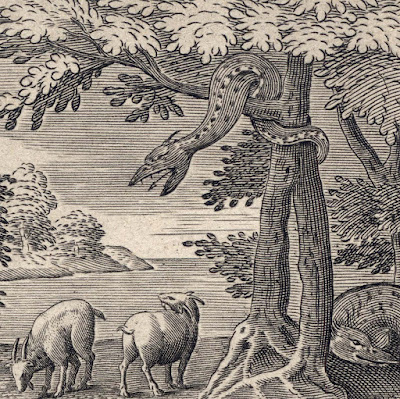Agostino Veneziano (aka Agostino
dei Musi) (1490–1540; fl.1509–36)
“The Israelites Gathering Manna” (aka “La
Manne”), 1520–25, published by Antonio Salamanca (1478–1562) after a
lost drawing by Raphael (1483–1520) proposed by the Curator of the
British Museum to be “for the fresco in the eighth arcade of the Vatican Logge
now replaced by a reproduction by Pietro Santi Bartoli.” The curator also advises: “There is a Raphael
school drawing believed to be the model for the engraving now at Christ Church
in Oxford (n.1817)” (see BM no. H,9.6).
Engraving on laid paper with narrow
margins backed with a support sheet.
Size: (sheet trimmed unevenly) 30.8 x 45
cm; (plate) 29.8 x 44.5 cm
Inscribed on plate at lower edge:
(centre) “.A.V.”; (right of centre) “Ant. Sal. exc.”
State ii (?) with the addition of the
publisher’s name, “Ant. Sal. exc.” (Antonio Salamanca).
TIB 26 (14) 8 (10) (Konrad Oberhuber
[ed.] 1978, “The Illustrated Bartsch: The Works of Marcantonio Raimondi and of
His School”, vol. 26, Abaris Books, New York, p. 17).
The British Museum offers the following
description of this print:
“The Israelites gathering manna; Moses
standing at left with his arms outstretched and holding a wand in his right
hand while figures around him kneel in thanks and gather manna into elaborately
decorated vessels”
See also the description of this print
at the Rijksmuseum:
Condition: richly inked and well-printed
impression with little or no signs of wear to the plate. The sheet is in
museum-quality condition (i.e. there are no significant tears, holes, folds, abrasions,
stains or foxing, but with minor signs of handling in terms of losses to
corners and surface marks in the margins), backed with a support sheet of
archival (millennium quality) washi paper.
I am selling this large, Renaissance
period and near faultless engraving for AU$480 (currently
US$356.67/EUR304.41/GBP271.60 at the time of posting this print) including
postage and handling to anywhere in the world (but not, of course, any import
duties/taxes imposed by some countries).
If you are interested in purchasing this
engraving executed around the time that Leonardo painted his “Mona Lisa”,
please contact me (oz_jim@printsandprinciples.com) and I will send you a PayPal
invoice to make the payment easy.
This print has been sold
My understanding of what this biblical scene
portrays is Moses—shown on the left with a wand—giving instructions from God to
the Israelites that they should gather the food called “manna”—described by Wikipedia
as “’a fine, flake-like thing’ like the frost on the ground” (https://en.wikipedia.org/wiki/Manna)
to sustain themselves during their travels in the desert. This description of manna
as being like frost is very appropriate. After all, if manna isn’t collected early in the
morning it melts with the heat of the desert sun. There is also an added
necessity to consume manna within the day as it tends to spoil—“go off”—with a
putrid stench and alive with maggots.
What I find truly amazing about this illustration is the very early
representation of what is now called a “thought” or “speech bubble” above
Moses’ head. In this area of spatial ambiguity is portrayed a heavenly forest, rich
with fruit and, importantly, little of bits of manna shown at the lower trunk
of the far left tree. Although I may be wrong, I assume that this heavenly
forest is a graphic representation of God’s “voice” in Moses’ head as I can see
radiating lines arising from his head. To give a context to this thought/speech
bubble, the following verse from “Exodus” may be helpful:
“Then said the LORD unto Moses: 'Behold,
I will cause to rain bread from heaven for you; and the people shall go out and
gather a day's portion every day, that I may prove them, whether they will walk
in My law, or not” (“Exodus”, Chapter 16, verse 4).


















































